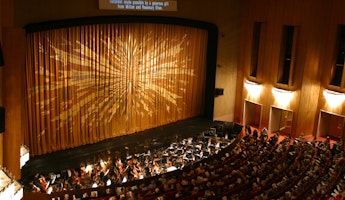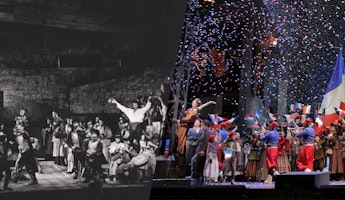Blog
April 9, 2023
"Otello": James Conlon's Note
Taken together, Giuseppe Verdi’s final two operas, Otello and Falstaff, represent a cultural monument, the crowning achievement of Italy’s greatest 19th-century genius, the zenith of Italian opera. Almost 140 years later, it is clear to all who know the Italian repertory well that this was the logical conclusion of more than 50 years of compositional development. Their very perfection created an impasse for the Italian theater similar to the crisis unleashed by Wagner’s Tristan und Isolde and underscored by the completion of the Ring and Parsifal.
Verdi inherited the traditional bel canto form, with the elegance, beauty and refinement bequeathed by Rossini, Bellini and Donizetti, and gradually reformed Italian opera, freeing it from the static closed forms of the early 19th century, the predominance (and just as often abuse) of vocalism and the tyranny of the prima donna. His inexhaustible search for dramatic subjects and musical-dramatic values, his liberation of the orchestra from the role of accompaniment, and his vast and impartial humanity constantly challenged and pushed the boundaries of the state of operatic composition. That lifelong process culminated in the composition of these two masterworks. Most opera lovers, and those who know Italian music well, will have no trouble in recognizing the overwhelming greatness of these two works. Significantly, many music lovers who don’t prefer Italian opera readily accept these works as great. Very often, the same persons who disparage Italian opera in general concede that these two are exceptional.
It is precisely to this last point that I would like to turn my attention. In my estimation, like many great works, their impact is immediate and requires no previous experience or contact with the composer. But their real significance and genius become more fully apparent when viewed in context. I recall my own first hearing of both operas at the age of 13, barely understanding a word of Italian or anything about life, and yet being literally overwhelmed by the power of the music.
Much is made today (often to a fault) of assessing the novelty of works in their historic context as a measure of the intrinsic value of their substance. Paradoxically, Otello and Falstaff—while breaking new ground, provoking and inspiring the next generations to propose a new aesthetic—represent, in my mind, logical conclusions more than novelties. Like the head of Janus, Otello looks both forward and backward. Both operas are accepted into the international pantheon whereas, paradoxically, too many earlier works which were, in fact, novel and avant-garden in their time, are subjected to some critical disdain. This is not true with the public—quite the contrary—but in certain critical milieux.
Shakespeare was read but not produced on stage in Italy until Verdi premiered Macbeth in 1847. No composer so consistently went to the edge politically, writing political subversion between the lines in the early Risorgimento operas. No other dared, as he did in his middle years, to create operas about society’s outsiders and antiheroes, portraying an outcast Roma woman (Il Trovatore), a hunchbacked buffoon (Rigoletto) and a courtesan (La Traviata) as protagonists. He insisted on writing his own embellishments and cadenzas to prevent singers from writing their own and misappropriating his music—only eventually to eliminate most vocal theatrics from his own vocabulary. He perfected the scene and aria, the cabaletta, the orchestral preludes—only to abandon all of them. He brought political drama to the stage (Macbeth, La Battaglia di Legnano, I Vespri Siciliani, Don Carlo, Simon Boccanegra) and experimented with epic drama (La Forza del Destino).
Through his gradual abandonment of closed forms (for example, arias and duets that have a beginning, a middle and an end, with full stop, applause-provoking endings), he grew to favor an uninterrupted dramatic flow. He transferred much of the musical substance to the orchestra, developing a declamatory/lyric style of recitation. The culmination of by now near-vestigial forms—the storm scene, the drinking song, the love duet, the concertato, the prayer—are bound together in Otello and Falstaff to perfection in a new way.
Similarly, he pushed dramatic vocalism into a new territory while summing up the full flowering of the traditional vocal archetypes he had inherited from the past. Desdemona, as personification of feminine compassion, has been distilled from his many examples of heroines embodying various degrees of goodness, beauty and generosity. She is descended from Elvira in Ernani, Luisa Miller, Gilda in Rigoletto, Leonora in Il Trovatore, Amelia in Un Ballo in Maschera, Elisabetta in Don Carlo, Aida and the Requiem soprano. Verdi had long weaned himself from the ambivalent models of Abigaille (Nabucco), Lucrezia (The Two Foscari) and Lady Macbeth.
But Iago is fundamentally and completely evil, to a degree that he has no direct counterpart. Coleridge’s famous description of “motiveless malignity” sets him apart from most other villains. But the lower male voices as nemeses or at least partially evil goes back to the very roots of Italian opera and was almost a cliché in the early 19th century. He personifies the wickedness of many baritones and basses of the 19th-century Italian repertoire. Iago’s roots can be traced through portrayals of ambiguous, sometimes sympathetic perpetrators of tragedy (Nabucco, Rigoletto, Macbeth, Renato in Un Ballo in Maschera, Germont in La Traviata) to those without redeeming virtues (Silva in Ernani, Wurm in Luisa Miller, Count di Luna in Il Trovatore, Don Carlos in La Forza del Destino, Amonasro in Aida). The most important, most recent and direct model for Iago is Paolo, Simon Boccanegra’s nemesis.
Conversely, the most striking novelty is Otello himself. Portraying the lover as tenor is not new, of course. But tenor as aging lover (as perhaps befits a composer in his seventies) is unique. Otello is Verdi’s last great tenor role. The difficulty of performing this role is prodigious. Few in the opera’s now long history could consistently hold the stage. Otello’s only leading tenor successor is light and lyric, a turn-around of 180 degrees: the youthful Fenton of Falstaff, lovingly sculpted as an octogenarian composer would conjure up youth. Tenor as poet, lover and military hero all have their models, but none is a tragic hero in the classical sense. Characteristically impetuous, their passion and excesses can often be explained away by youth and certainly be forgiven. From Manrico (Il Trovatore) to Don Carlo, Alfredo (La Traviata) to Radames (Aida), they variously personify inherent goodness led astray. Don Alvaro (La Forza del Destino) and Riccardo (In Ballo in Maschera) exhibit more inner nobility of spirit. His portrayal of Otello as fatally flawed hero is the most demanding use of the dramatic tenor’s full vocal and histrionic potential. Otello crowns Verdi’s ability to stretch the limits and it stands as the tenor's apotheosis in the Italian operatic tradition.
Finally, the enrichment of the orchestra and the symphonic development of Otello and Falstaff owe greatly to Beethoven, to Wagner (although how much is still an open question) and partially to the growing interest in Milan for symphonic music. Every opera after Un Ballo in Maschera (including the revised versions of Macbeth and Simon Boccanegra) shows massive steps. The orchestration of Otello has already integrated the lessons of Fontainebleau and Imperial Spain, the Scottish heath (revisited), the Genovese council chamber scene, ancient Egypt and the Dies Irae. The Act One storm and love duet, the Cypriots’ hymn of praise to Desdemona, Otello’s soliloquy, the Willow Song and the Ave Maria, and the contrabass solo of Act Four, to cite but a few examples, have precedents but no equals. The Act Three trio sets out the stage for Falstaff.
To summarize, no greater Italian masterwork exists. Like all masterworks, it is greater than the sum of all possible performances. Its majesty is not dependent on those who interpret it. Despite all the possible dramatic misadventures or vocal inadequacies, a performance of Otello cannot fail because it is so perfectly conceived and so masterfully executed that not a single note is superfluous or less than inspired. Verdi was to the 19th century what Haydn was to the 18th. Both composers, blessed with long lives, constantly evolved throughout the years, and wrote their greatest works at the end. Verdi left not only his most sublime works, but two that can rightly be considered the pinnacle of a now 400-year-old tradition born in Renaissance Florence. Monteverdi helped to create it, and Verdi to perfect it.
James Conlon has been the Richard Seaver Music Director of LA Opera since 2006.
@ 2023 James Conlon
/terenceblanchard_hero.jpg?format=auto&fit=crop&w=226&h=140&crop=focalpoint&fp-y=0&auto=format&auto=format)







/03-cosi/_dsc0996_pr.jpg?format=auto&fit=crop&w=345&h=200&auto=format)








/terenceblanchard_hero.jpg?format=auto&fit=crop&w=372&h=380&crop=focalpoint&fp-y=0&auto=format&auto=format)






